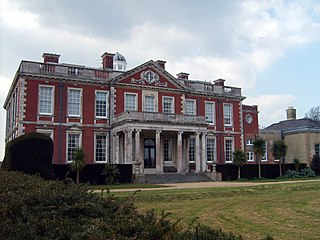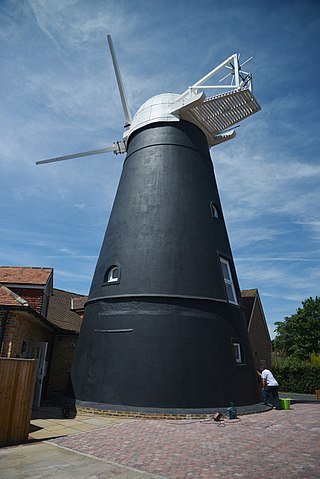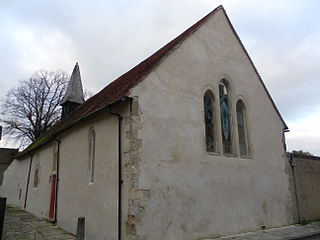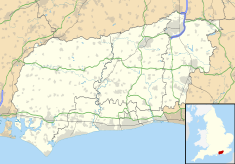
In architecture, a folly is a building constructed primarily for decoration, but suggesting through its appearance some other purpose, or of such extravagant appearance that it transcends the range of usual garden buildings.

Chichester is a cathedral city and civil parish in West Sussex, England. It is the only city in West Sussex and is its county town. It was a Roman and Anglo-Saxon settlement and a major market town from those times through Norman and medieval times to the present day. It is the seat of the Church of England Diocese of Chichester, with a 12th-century cathedral.

Westbourne is a village, civil parish and electoral ward in the Chichester District of West Sussex, England. It is located 0.5 miles (0.80 km) north east of Emsworth. The parish includes the hamlets of Woodmancote and Aldsworth, and once included the settlements of Southbourne and Prinsted to the south.

Stansted Park is an Edwardian country house in the parish of Stoughton, West Sussex, England. It is near the city of Chichester, and also the village of Rowlands Castle to the west over the border in Hampshire.

The River Ems is a much-sluiced, six miles (9.7 km) river that is located in the far west of the county of West Sussex, England.The last one and a half miles (2.4 km), of this river, delimits eastern Hampshire, before flowing into the sea at Chichester Harbour.

John Baker's Mill is a grade II listed tower mill at Barnham, Sussex, England, which was under restoration and is now to be converted to residential use.

Walter's Mill is a tower mill at Mark Cross, Sussex, England which has been converted to residential accommodation.

All Saints Church is the Anglican parish church of Patcham, an ancient Sussex village which is now part of the English city of Brighton and Hove. A place of worship has existed on the hilltop site for about 1,000 years, but the present building has Norman internal features and a 13th-century exterior. Several rounds of restoration in the Victorian era included some structural additions. A wide range of monuments and wall paintings survive inside, including one commemorating Richard Shelley—owner of nearby Patcham Place and one of the most important noblemen in the early history of Brighton. The church, which is Grade II* listed, continues to serve as the Anglican place of worship for residents of Patcham, which 20th-century residential development has transformed from a vast rural parish into a large outer suburb of Brighton.

St Peter's Church is an Anglican church in the West Blatchington area of Hove, part of the English city of Brighton and Hove. Although it has 11th- and 12th-century origins, the church was rebuilt from a ruined state in the late 19th century and extended substantially in the 1960s, and little trace remains of the ancient building. The church serves the parish of West Blatchington, a residential area in the north of Hove near the border with Brighton.

St John the Evangelist's Church is the Church of England parish church of Burgess Hill, West Sussex, England. It is a Gothic Revival church built of local bricks. It was consecrated in 1863 and was the town's first Church of England church. Since then it has administered several other churches in the town as either mission chapels or daughter churches, but all have either closed or been given their own parishes. The church is a Grade II* Listed Building.

St Matthew's Church is an Anglican church in the Silverhill suburb of Hastings, a town and borough in the English county of East Sussex. The present building, a large brick structure of 1884 by ecclesiastical architect John Loughborough Pearson, replaced a much smaller church founded in 1860 when Silverhill began to grow from an agricultural area with scattered cottages into a suburb of the increasingly fashionable seaside resort of Hastings. Although a planned tower was never built, the "imposing" church dominates its steeply sloping site; and although its architect—a leading Gothic Revivalist—considered it one of his lesser works, it has been described as "outstanding" and "architecturally inventive". English Heritage has listed the building at Grade II* for its architectural and historical importance.

Preston Manor is the former manor house of the ancient Sussex village of Preston, now part of the coastal city of Brighton and Hove, England. The present building dates mostly from 1738, when Lord of the manor Thomas Western rebuilt the original 13th-century structure, and 1905 when Charles Stanley Peach's renovation and enlargement gave the house its current appearance. The manor house passed through several owners, including the Stanfords—reputedly the richest family in Sussex—after several centuries of ownership by the Diocese of Chichester and a period in which it was Crown property.

St Mary the Virgin's Church is a redundant Anglican church near the village of Stansted Mountfitchet, Essex, England. It is recorded in the National Heritage List for England as a designated Grade II* listed building, and is under the care of the Churches Conservation Trust. It stands about 1 mile (1.6 km) to the southeast of the village in the grounds of Stansted Hall. The church has been listed because of its "historical value and internal features".

St Botolph's Church is a redundant Anglican church near the village of Skidbrooke, Lincolnshire, England. It is recorded in the National Heritage List for England as a designated Grade I listed building, and is under the care of the Churches Conservation Trust. It stands in an isolated position in the Lincolnshire marshlands, about 7 miles (11 km) northeast of Louth, and to the west of the A1031 road.

Graylingwell Hospital was a psychiatric hospital in Chichester, West Sussex, United Kingdom.

St Catherine of Siena Church is an Anglican parish church in Cocking, a village in the district of Chichester, one of seven local government districts in the English county of West Sussex.
Theodosius Keene, born in 1754, was an English architect who conducted most of his work in the south of England between 1770 and 1777.

County Hall is a municipal facility at West Street in Chichester, West Sussex. It is the headquarters of West Sussex County Council.

St Andrew-in-the-Oxmarket Church is a former Anglican church in the centre of the cathedral city of Chichester in West Sussex, England. The building has existed since the 13th century and was used as a church from then until the mid 20th century, when wartime damage forced it to close. It is now an arts centre, having been converted in 1976 and extended 13 years later. Historic England has listed the building at Grade II* for its architectural and historical importance.
























